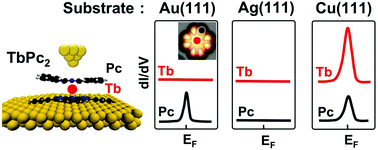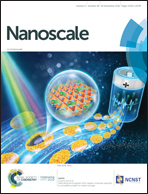Screening the 4f-electron spin of TbPc2 single-molecule magnets on metal substrates by ligand channeling†
Abstract
Bis(phthalocyaninato)lanthanide (LnPc2) double-decker-based devices have recently attracted a great deal of interest for data encoding purposes. Although the 4f-electrons of lanthanide ions play a key role in the experimental methodology, their localized character, deeper in energy compared to the 3d electrons of transition metals, hampers a detailed investigation. Here, our approach consists of the follow-up of the entanglement process with other molecules and with the substrate electrons by means of space-resolved detection of the Kondo resonance by scanning tunneling spectroscopy (STS), using different substrates (from weak to strong interaction). It is found that TbPc2 molecules firstly interact with their environment by means of the π-radicals of the ligand. The radical spin of TbPc2 can be identified by STS on a weakly interacting substrate such as Au(111). In the case of a Ag(111) substrate, we are able to analyze the effect of an electron transfer on the molecule (pairing-up of the radical spin) and the subsequent quenching of the Kondo resonance. Finally, on a strongly interacting substrate such as Cu(111), a significant rearrangement of electrons takes place and the Kondo screening of the 4f electrons of the Tb ion of TbPc2 is observed. By comparative STS measurements on YPc2, that has empty 4d and 4f shells, we prove that the Kondo resonance measured in the center of the TbPc2 molecule indeed stems from the 4f-electrons. At the same time, we provide evidence for the hybridization of the 4f states with the π electron.



 Please wait while we load your content...
Please wait while we load your content...